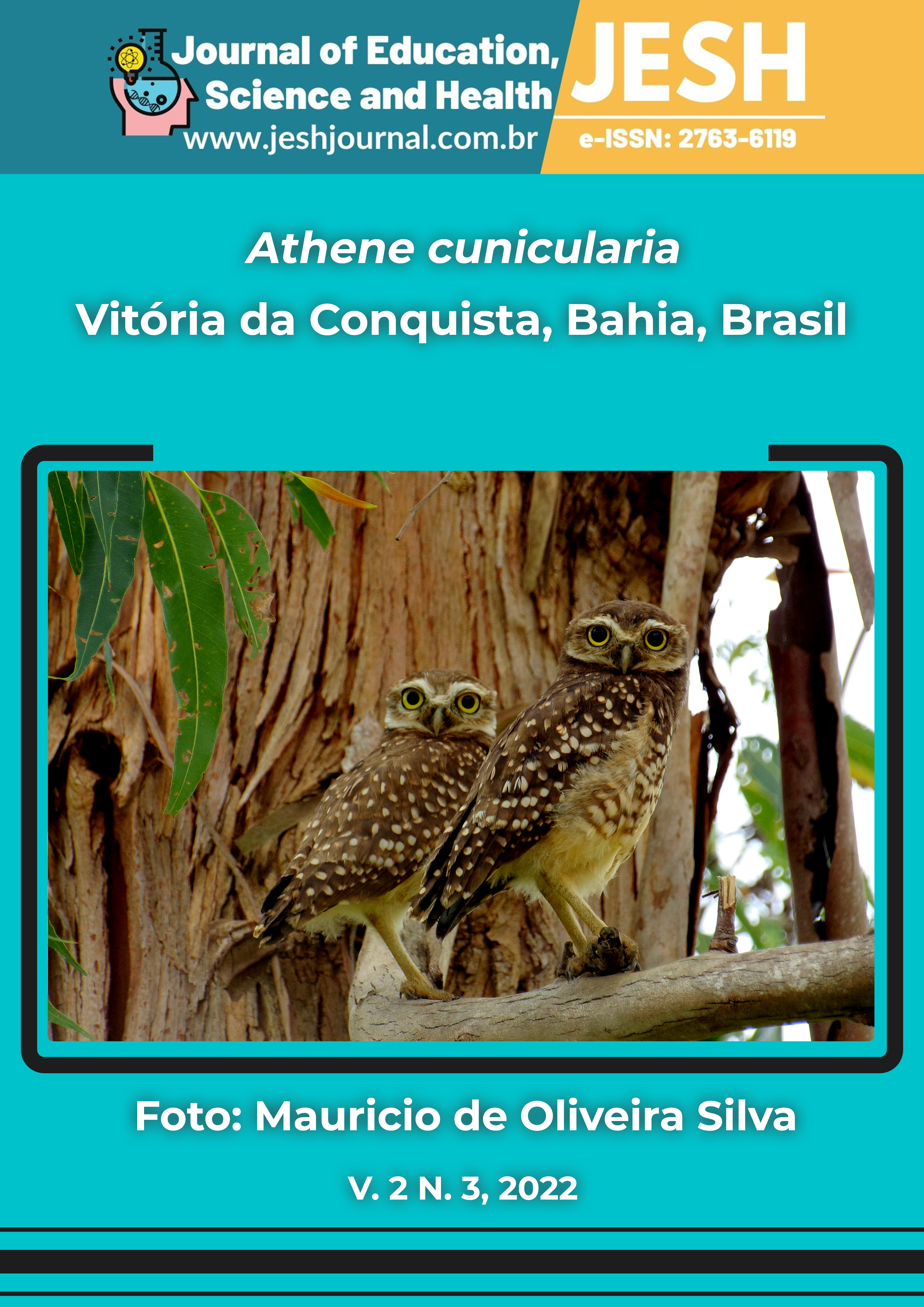Using citizen science to disseminate information about the Brazilian funga
DOI:
10.52832/jesh.v2i3.142Abstract
Citizen science corresponds to the incorporation of knowledge from people not directly involved with the academic environment in the production of scientific knowledge. Biodiversity monitoring is one of the types of projects that benefit from citizen science participation, since research centers often do not have enough resources to collect relevant information about local species. In surveying the diversity of macrofungi, citizen science projects are essential, as we are referring to ephemeral, seasonal reproductive structures that often have restricted distribution. In this work we present data regarding the Grupo Cogumelos do Brasil, a virtual community on the social network Facebook that was created in 2013. Between May and June 2021, a survey of species was carried out based on photographs posted in the group. After following-up for one month, we found that 61 members from 17 Brazilian states published photographs of at least 126 different taxa of macrofungi (ascomycetes and basidiomycetes). Furthermore, case studies are presented that demonstrate the potential of this group for future studies involving citizen science.
Downloads
Metrics
References
Arazy, O., & Malkinson, D. (2021). A framework of observer-based biases in citizen science biodiversity monitoring: semi-structuring unstructured biodiversity monitoring protocols. Frontiers in Ecology and Evolution, 9, article 693602. https://doi.org/10.3389/fevo.2021.693602 DOI: https://doi.org/10.3389/fevo.2021.693602
Bas, C. (1969). Morphology and subdivision of Amanita and a monograph on its section Lepidella. Persoonia, 5(4), 285–579.
Bas, C. (1978). Studies in Amanita. I. Some Amazonian species. Persoonia, 10(1), 1–22.
Brazilian Flora Group – BFG (2022). Brazilian Flora 2020: leveraging the power of a collaborative scientific network. Taxon, 71(1), 178–198. https://doi.org/10.1002/tax.12640 DOI: https://doi.org/10.1002/tax.12640
Campi, M., Maubet, Y., & Trierveiler-Pereira, L. (2021). Rediscovery of Clathrus argentinus and new contributions to the gasteroid mycobiota of Paraguay. Current Research in Environmental & Applied Mycology, 11(1), 90–111. https://doi.org/10.5943/cream/11/1/8 DOI: https://doi.org/10.5943/cream/11/1/8
Cartwright, J. (2016). Technology: Smartphone science. Nature, 531, 669–671. https://doi.org/10.1038/nj7596-669a DOI: https://doi.org/10.1038/nj7596-669a
Dring, D. M. (1980). Contributions towards a rational arrangement of the Clathraceae. Kew Bulletin, 35, 1–96. DOI: https://doi.org/10.2307/4117008
Ediriweera, A. N., Karunarathna, S. C.; Xu, J., Hyde, K. D., & Mortimer, P. E. (2017). Entoloma mengsongense sp. nov. (Entolomataceae, Agaricales), a remarkable blue mushroom from Yunnan Province, China. Turkish Journal of Botany, 41, 505–515. https://doi.org/10.3906/bot-1611-13 DOI: https://doi.org/10.3906/bot-1611-13
Fazolino, E. P., Trierveiler-Pereira, L., Calonge, F. D., & Baseia, I. G. (2010). First records of Clathrus (Phallaceae, Agaricomycetes) from the Northeast Region of Brazil. Mycotaxon, 113, 195–202. DOI: https://doi.org/10.5248/113.195
Flora do Brasil (2020) Agaricales. Flora do Brasil 2020, Jardim Botânico do Rio de Janeiro. http://floradobrasil.jbrj.gov.br/reflora/floradobrasil/FB12
Gura, T. (2013). Citizen science: Amateur experts. Nature, 496, 259–261. https://doi.org/10.1038/nj7444-259a DOI: https://doi.org/10.1038/nj7444-259a
Guzmán, G. (2003). Los hongos de El Edén, Quintana Roo. Introducción a la micobiota tropical de México. Xalapa: Instituto de Ecología. DOI: https://doi.org/10.1590/S0036-46652004000500017
Karstedt, F., & Capelari, M. (2013). Inocephalus (Entolomataceae, Agaricales) from São Paulo State, Brazil. Nova Hedwigia, 96, 279–308. https://doi.org/10.1127/0029-5035/2012/0055 DOI: https://doi.org/10.1127/0029-5035/2012/0055
Meijer, A. A. R. (2006). Preliminary list of the macromycetes from the Brazilian State of Paraná. Boletim do Museu Botânico Municipal, Curitiba, 68, 1–55.
Menolli Jr., N., Capelari, M., & Baseia, I. G. (2009). Amanita viscidolutea, a new species from Brazil with a key to Central and South American species of Amanita section Amanita. Mycologia, 101(3), 395–400. https://doi.org/10.3852/07-079 DOI: https://doi.org/10.3852/07-079
Michelot, D. & Melendez-Howell, L. M. (2003). Amanita muscaria: chemistry, biology, toxicology, and ethnomycology. Mycological Research, 107(2), 131–146. DOI: https://doi.org/10.1017/S0953756203007305
Neves, M. A., & Furtado, A. (2020). The IUCN Red List of Threatened Species 2020: Amanita viscidolutea. https://dx.doi.org/10.2305/IUCN.UK.2020-3.RLTS.T172740193A172861167.en. DOI: https://doi.org/10.2305/IUCN.UK.2020-3.RLTS.T172740193A172861167.en
Pocock, M. J. O, Chandler, M., Bonney, R., Thornhill, I., Albink, A., August, T., Bachman, S., Brown, P. M. J., Cunha, D. G. F., Grez, A., Jackson, C., Peters, M., Rabarijaonkk, N. R., Roy, H. E., Zaviero, T., & Danielsen, F. (2018). A vision for global biodiversity monitoring with citizen science. Advances in Ecological Research, 59, 169–223. https://doi.org/10.1016/bs.aecr.2018.06.003 DOI: https://doi.org/10.1016/bs.aecr.2018.06.003
Rick, J. (1931). Monographia Pezizinearum Riograndensium. Brotéria, Série Botânica, 25, 77–98.
Saccardo, P. A. (1887). Sylloge fungorum omnium hucusque cognitorum, Vol. 5. Agaricineae. Pádua: Typis Seminarii.
Scheibler, G. (2019). Sistemática de Amanita Pers. (Amanitaceae, Basidiomycota) no Brasil. (Dissertação de Mestrado, Programa de Pós-Graduação em Biologia de Fungos, Algas e Plantas, Universidade Federal de Santa Catarina)
https://repositorio.ufsc.br/bitstream/handle/123456789/215338/PBFA0052-D.pdf?sequence=-1
Sistema de Informação sobre a Biodiversidade Brasileira – SiBBr (2022). Ciência Cidadã: o que é Ciência Cidadã? https://sibbr.gov.br/cienciacidada/oquee.html?lang=pt_BR
Shirk, J. L., Ballard, H. L., Wilderman, C. C., Phillips, T., Wiggins, A., Jordan, R., McCallie, E., Minarchek, M., Lewenstein, B.V., Krasny, M. E., & Bonney, R. (2012). Public participation in scientific research: a framework for deliberate design. Ecology and Society, 17(2), article 29. http://dx.doi.org/10.5751/ES-04705-170229 DOI: https://doi.org/10.5751/ES-04705-170229
Strasser, B. J., Baudry, J., Mahr, D., Sanchez, G., & Tancoigne, E. (2019). “Citizen Science”? Rethinking science and public participation. Science & Technology Studies, 2(2), 52–76. https://doi.org/10.23987/sts.60425 DOI: https://doi.org/10.23987/sts.60425
Sydow, H., & Sydow, P. (1907). Verzeichnis der von Herrn F. Noack in Brasilien gesammelten Pilze. Annales Mycologici, 5(4), 348–363.
Trierveiler-Pereira, L. (2015). Phalloid fungi (Phallales) of Brazil. Field Guides, The Field Museum, n. 716.
https://fieldguides.fieldmuseum.org/guides/guide/716
Trierveiler-Pereira, L. (2022). Clathrus. Flora do Brasil 2020, Jardim Botânico do Rio de Janeiro. http://floradobrasil.jbrj.gov.br/reflora/floradobrasil/FB92655
Trierveiler-Pereira, L., Baltazar, J. M., Loguercio-Leite, C. (2008). Notes on Chlorociboria (Helotiales, Ascomycota) in Southern Brazil. Mycotaxon, 104, 415–421.
Viana, B., & Queiroz, C. (2020). Ciência cidadã para além da coleta de dados.
https://www.comciencia.br/ciencia-cidada-para-alem-da-coleta-de-dados
Downloads
Published
How to Cite
Issue
Section
License
Copyright (c) 2022 Journal of Education, Science and Health – JESH

This work is licensed under a Creative Commons Attribution-NonCommercial 4.0 International License.

































